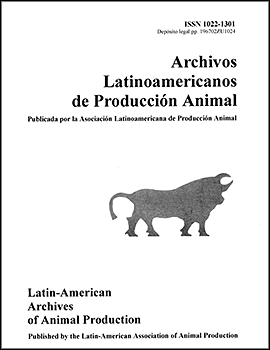
|
Archivos Latinoamericanos de Produccion Animal
Asociacion Latinoamericana de Produccion Animal
ISSN: 1022-1301
EISSN: 1022-1301
Vol. 12, No. 3, 2004, pp. 112-120
|
 Bioline Code: la04014
Bioline Code: la04014
Full paper language: Spanish
Document type: Research Article
Document available free of charge
|
|
|
Archivos Latinoamericanos de Produccion Animal, Vol. 12, No. 3, 2004, pp. 112-120
| en |
Comparison of water buffalo ( Bubalus bubalis  ) vs Zebu-type intact males bovines in slaughter characteristics, carcass traits, cutability and longissimus palatability ) vs Zebu-type intact males bovines in slaughter characteristics, carcass traits, cutability and longissimus palatability
S. Merle, J. Sencleer, A. Rodas-Gonzalez, J. Gonzalez, D. Mansutti y N. Huerta-Leidenz.
Abstract
Twenty-seven intact male water buffaloes of Murrah breeding (BUFFALOES) and 18 Zebu type bulls (CATTLE) were savannah-fed on the same ranch and slaughtered when they reached a desirable conformation to be compared in slaughter characteristics, carcass traits, cutability and meat palatability. Slaughter weight ranged 435 to 512kg for BUFFALOES and 375 to 494kg for CATTLE. Least square mean differences between species in percent head, cooler shrink, feet, blood and genitals were not significant (P>.05). BUFFALOES had significantly heavier hides, larger gastrointestinal tract and higher (P>.05) percentages of liveweight removed as organ fat. These body components are partly responsible for the significantly lower dressing percentages (- 6.5 %) of BUFFALOES vs CATTLE. Non-significant differences were found between species for total percentages of trimmed fat and bone, and percent yield (P>.05) of the most expensive (high valued, boneless) cuts. CATTLE yielded higher percentages (P<.05) of the medium-valued cuts (+1.39%) and the composite group of boneless (high and medium valued) cuts (+2.06%); whereas buffaloes exceeded (+.86%) cattle in the proportion of low-valued cuts (P<.05). Significant Specie x Carcass weight interactions were detected for some retail components. Longissimus steaks from CATTLE exhibited higher (P<.001) shear values (5.05kg vs 3.52kg) (P<.001) and lower (P>.05) overall tenderness ratings (4..3 vs 4.8). It was concluded that commercial disadvantages of BUFFALOES in dressing percent and cutability detected herein, could be overcome by designing marketing strategies promoting the buffalo meat as a high-quality product.
Keywords
Water Buffalo, Cattle, Beef, Carcass Composition, Carcass Weight.
|
| |
| es |
Comparación de machos enteros búfalos de agua ( Bubalus bubalis  ) vs vacunos acebuados en características al sacrificio, de la canal, rendimiento carnicero y palatabilidad del longissimus. ) vs vacunos acebuados en características al sacrificio, de la canal, rendimiento carnicero y palatabilidad del longissimus.
S. Merle, J. Sencleer, A. Rodas-Gonzalez, J. Gonzalez, D. Mansutti y N. Huerta-Leidenz.
Resumen
Veintisiete machos enteros Murrah (BUFALOS) y 18 animales acebuados (VACUNOS) del mismo sexo, producidos bajo condiciones de sabana, fueron sacrificados al alcanzar una conformación deseable, para ser comparados en características al sacrificio y en canal, rendimiento carnicero y palatabilidad del longissimus. Los rangos de peso al sacrificio fueron 435 a 512kg para BUFALOS y 375 a 494kg para VACUNOS. Por mínimos cuadrados, no se detectó variación entre especies (P>.05) en el porcentaje de cabeza, mermas por frío, patas, sangre y genitales. Con relación a su masa corporal, los BUFALOS tenían proporcionalmente cueros más pesados, tractos gastrointestinales más grandes y mayor deposición de (P<.05) grasa en órganos, haciéndolos rendir 6.5% menos en canal que los VACUNOS. Las especies no se diferenciaron (P>.05) en proporción de cortes deshuesados de alto valor, grasa recortada y hueso limpio. Los VACUNOS, rindieron más (P>.05) en cortes de mediano valor (+1.39%) y total de cortes valiosos (+2.06%); mientras que los BUFALOS tuvieron mayor proporción de cortes de bajo valor (+.86%; P>.05). La interacción especie x peso de la canal fue significativa para algunos cortes. La carne de VACUNOS necesitó más fuerza de corte (5.05 vs 3.52kg) (P<.001) y obtuvo una puntuación más baja (P<.05) en terneza (4.3 vs 4.8). Las desventajas de rendimiento, tanto en canal como en cortes de BUFALOS frente a VACUNOS podría compensarse a través de estrategias de mercado para promover una carne de alta calidad.
Palabras-clave
Búfalo de Agua, Vacunos, Carne, Composición de la Canal, Peso de la canal
|
| |
© © Copyright 2004 ALPA. Arch. Latinoam. Prod. Anim.
Alternative site location: http://www.alpa.org.ve/ojs/index.php
|
|
